In the landscape painting of the beloved Finnish artist Pekka Halonen (1865-1933), the Finnish lake is presented in misty winter day. Water is covering the icy lake – the spring is coming. The hyperspectral image of the same painting, however, tells another story. The icy lake covers a handsome gentleman with imposing sideburns.
Science, in this case, can reveal over hundreds of years what an artist has been thinking when painting an artwork. Or who would have imagined that a dead woman hidden behind the veil will be revealed again after decades with the help of modern technology. Now it is possible, explains Tiina Koivulahti, who is both an expert in art history and CEO of RECENART, a company which is specialised in scientific methods in art analysis.
A new, rapidly growing company operating in Finland applies the latest technology when studying works of art by using state-of-the-art techniques. A material technical analysis can provide accurate information on paintings and archaeological objects. This is not just about the pigments but, for example, the varnish, contaminants, canvas and so on. Many pigments and other materials used are products of their own time. By knowing the technical and physical characteristics of these materials and the artists who may have used the certain materials, the date when the work of art was created can be traced down – allowing for modern pigments and forgeries to be easily distinguished. The same applies to the artist when his/her typical palette is known and available material data can be compared. It is often the case that the analysis of an artwork is sort of forensic art analysis, Koivulahti continues.
Additionally, an image analysis can often reveal what is underneath the visible layers of paint. Sometimes there are drafts, signatures and other markings. The hyperspectral cameras enable RECENART scientists to analyse artistic processes, underdrawings, possible earlier paintings and vanished signatures. Ultimately, the individual pigments can be identified from the spectral data, which is important when dating an artwork. No other technology can provide such combination of valuable information as hyperspectral imaging analysis.
The imaging analysis is traditionally based on taking an X-ray or infrared image of the painting. Today, however, much finer details can be obtained with hyperspectral cameras. These type of cameras are more commonly used in space and satellite systems and now, by the RECENART, they are applied in analysis of the artworks.
“Normal photographs provide 3 colours: red, green and blue. This type of information is known as RGB. Similarly, the human eye has only 3 different cell-types which can recognise colours (one for each of the RGB). Hyperspectral cameras used by RECENART can recognise more than 600 different ‘colours’. The cameras also work in a four times wider wavelength area than is seen by the human eye.” Says physicist Mikko Laitinen, who is responsible for the hyperspectral imaging.
With the help of a large number of ‘colors’ imported by the hyperspectral cameras, computer calculations can also be used to gain access to the paint layers not visible to bare eye – it´s like peeling an onion. When looking at longer wavelengths, information can also be obtained much deeper from the artwork but in great detail compared to X-rays, Laitinen illustrates. In the following there are few examples of what hyperspectral images can reveal, which are impossible to other methods such as normal IR imaging or X-rays used in the art analysis field.
The lake landscape of figure 1 was painted on top of a portrait of a gentleman. Up left is the image in normal light, on the right is traditional IR-image. Below are hyperspectral images processed with two different spectral parameters.
Case 1: Halonen
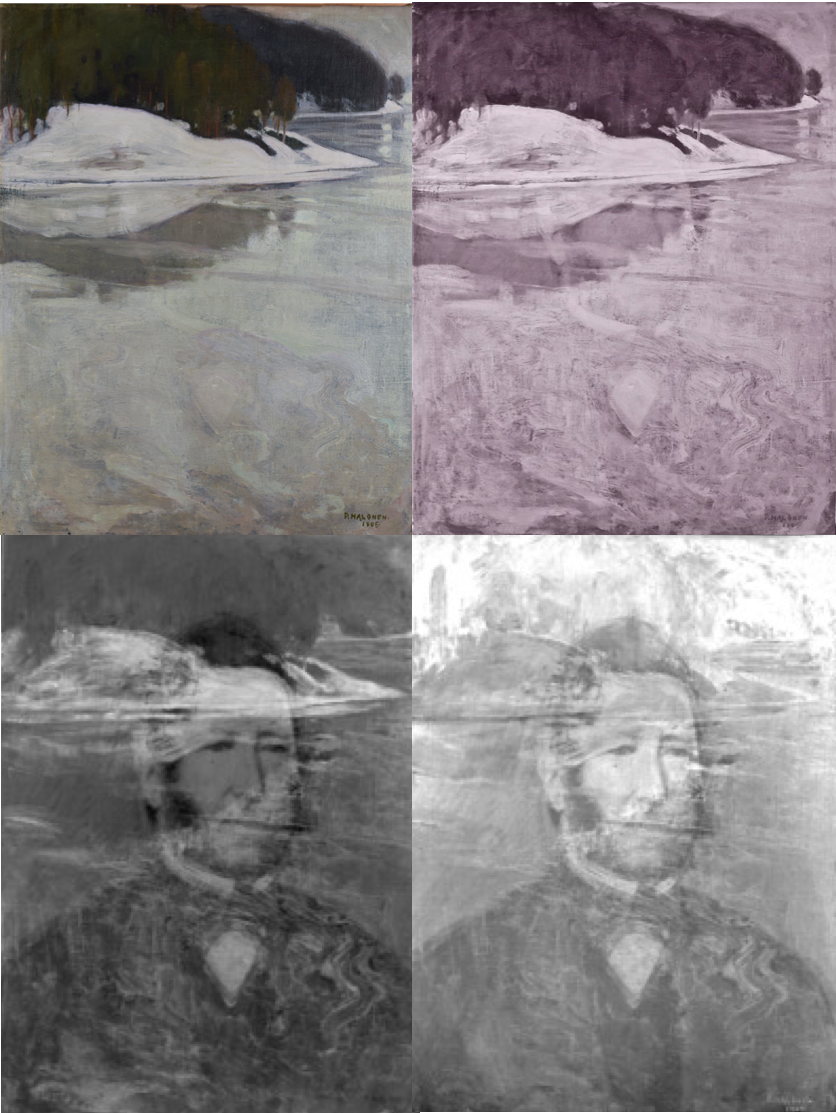
Even though cameras provide answers to what lies under the paint layers, more puzzles will typically emerge from the images underneath.
Why is the portrait covered? Was the artist dissatisfied with his work? Was it that the patron decided not to buy the artwork after all, and Halonen re-used the fabric again? In this case, the quality of the hyperspectral data reconstruction is so good that the man in the canvas could easily be recognised, if an art historian wanted to make a deeper study into the history of this painting.
Case 2: The Death of Virgin Mary
In the spring, the painting representing three women came to the RECENART premises. The subject of the painting was clearly religious. The good thing about religious subjects is that usually art historians are able to tell the subject, based on certain attributes. Now, however, the art historians hesitated in their conclusions, as the attributes clarifying the identity of the subjects in the painting were not evident as can be seen in the figure 2.
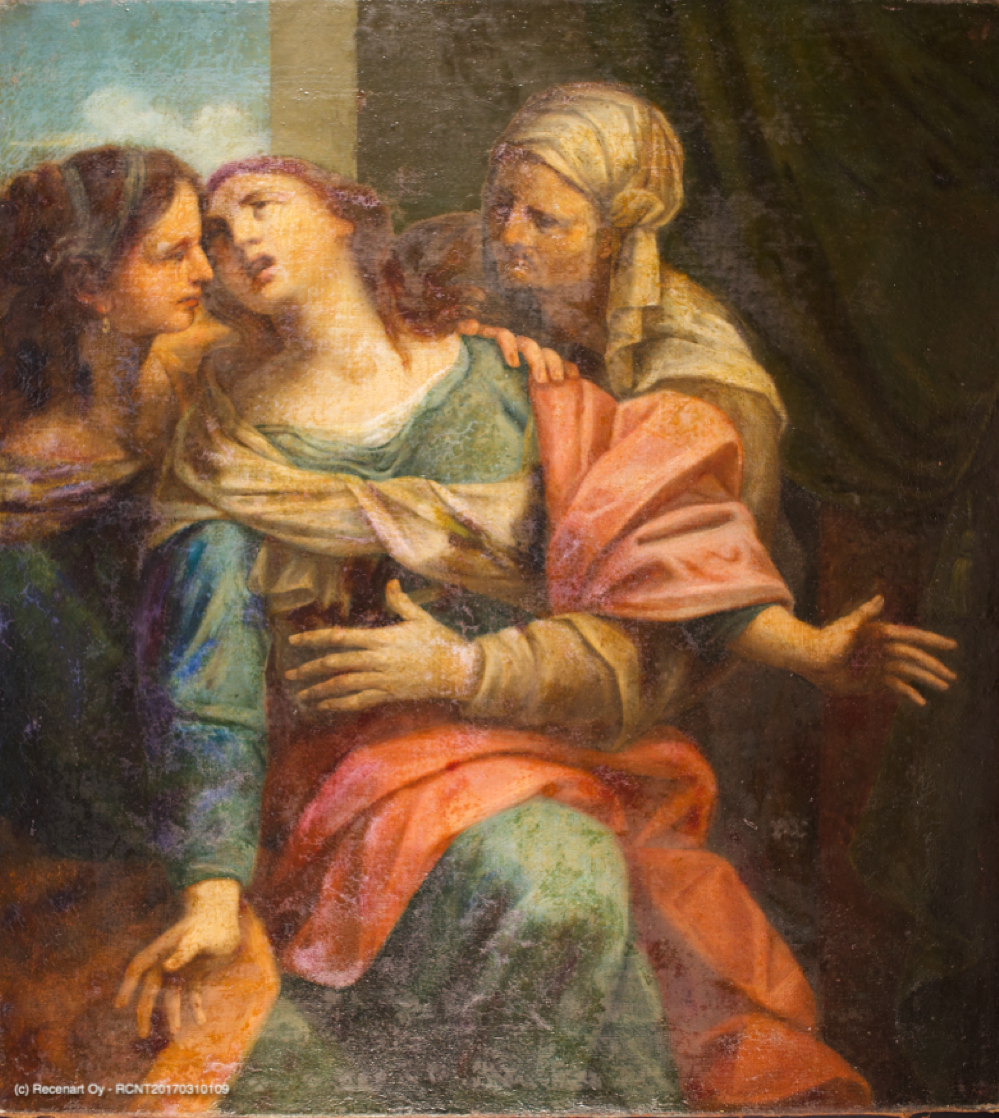
The work was imaged with hyperspectral camera and the imaging (figure 3) and data processing revealed a dead woman in the upper corner of the artwork. The presence of the dead woman was not first discovered from the normal infrared images, but in hyperspectral imaging the subject of the whole painting became evident. The work presents either the death of Virgin Mary or the death of Saint Anne, the mother of Virgin Mary.
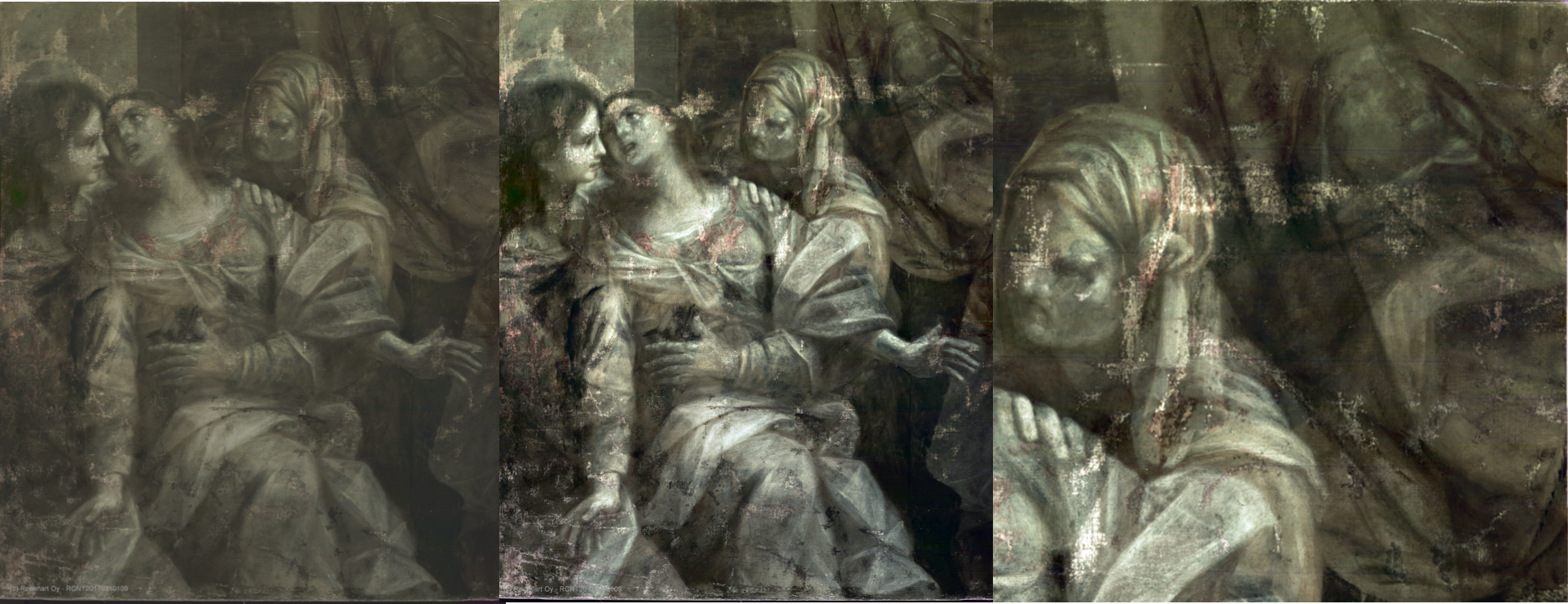
Again there are open questions to be answered. The researchers are now wondering why the dead figure had to be hidden later? Was it too scary on the wall? Or was it because of the fall of the Virgin Mary’s cult related to the Protestant Reformation?
Case 3: Frans Hals
The alleged Frans Hals painting was bought by a private collector in the 1930s. The infrared image did not reveal the still-life painting underneath. After hyperspectral imaging the still-life with flowers was seen clearly.
Gösta Serlachius bought the painting in the 1930’s. Serlachius was sceptical of the authenticity of the artwork and wanted to confirm the authenticity from the leading Frans Hals experts in Europe. Most of them believed in the authenticity of the work, however, and Serlachius decided to buy the portrait of the lady despite his doubts. A few years after buying the painting, a message came from the Frans Hals museum in the Netherlands: they doubted the painting was a genuine Frans Hals.
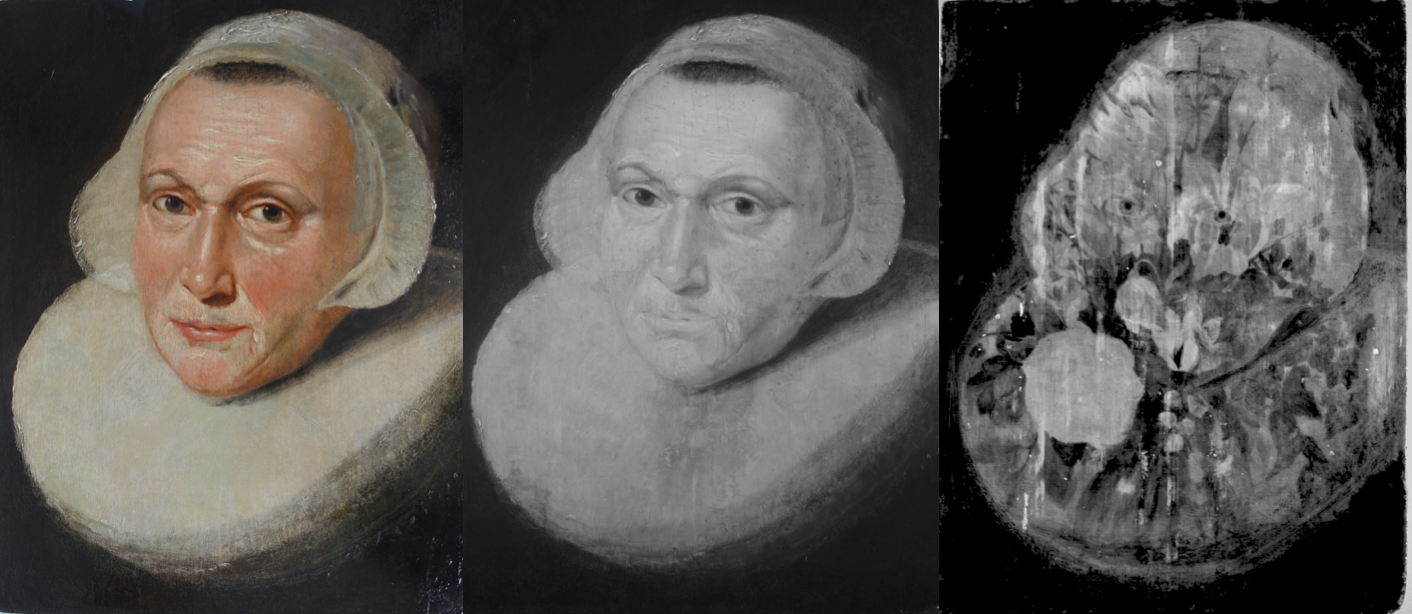
In this spring, Gösta Serlachius’s doubts were confirmed when the work was scientifically analysed. According to pigment analysis, a woman’s portrait is painted in the 30’s on an old panel with an earlier floral painting already in it.
Often forgeries do not leave many questions. It is clear that in the 30’s Frans Hals had been a popular artist whose works have raised good prices. Hence, the forgery was done in his name using an old panel that also Frans Hals could have been used. The work was sold in time at a better price than the then floral painting – however, today’s original portrait would be more valuable than the artwork it is now.
What RECENART does.
RECENART is analysing art based on the scientific facts and not by individual opinions. As the art market is traditionally not regulated in any way, the RECENART brings the long needed transparent risk management to the players in the field. Much money is put into the artworks, but usually the buyer has to rely on the opinion of various experts, connoisseurs, or the good knowledge and intentions of the seller. The evaluation is often based on an opinion and lacks scientific facts.
“Unfortunately, this has been the way of the art market for a long time and in many cases still is”, says Laura Aineslahti, who often responds to customer concerns and hopeful contacts about the authenticity of their artworks. As the art market attracts large amounts of money, there has always been a risk of buying a forgery – as the over 20 million € ongoing trial in Finland demonstrates. On the other hand, some of the purchased artwork may be from a brush of an old master and is waiting for re-discovery. Results provided by the RECENART from the artworks are not subjective opinions, but based on science. The results can always be verified, says Aineslahti.
RECENART provides risk management and safety to public and private collectors, galleries, banks, and insurance companies when works of art are traded/bought, insured or used as a collateral. The ability to provide a wide range of services is backed by the cutting-edge techniques and science. RECENART applies 13 different state-of-the-art technologies in imaging and material technical analysis.
The idea is to offer private and public customers access to analysed information about their art objects. The Artwork Check costs less than one thousand euros, but if you want a thorough analysis of the materials used and imaging services and the art historical analysis done to your artwork, the analysis services costs more, but can provide concrete evidences about the authenticity or many other mind puzzling questions. Analysed artworks provide security for the purchaser and vendor of the artwork. It also always gives new information about the work of art, creating an interesting story to it and by which the art work is also easier to sell.
RECENART raised an interest in international art market in 2015, by confirming a Claude Monet painting authentic. The pigments were exactly the same as in another Monet Haystack paintings series. A signature with the date was also found underneath a paint layer by hyperspectral camera.
RECENART is analysing the artworks in London, Paris and Frankfurt in our partner´s locations. For collections RECENART is able to analyse the artworks on their customers’ premises thanks to their mobile laboratory. Ask more www.recenart.com.
RECENART – Research Centre for Art Pictures in full size
laura.aineslahti@recenart.com
www.recenart.com
+358 40 750 6415

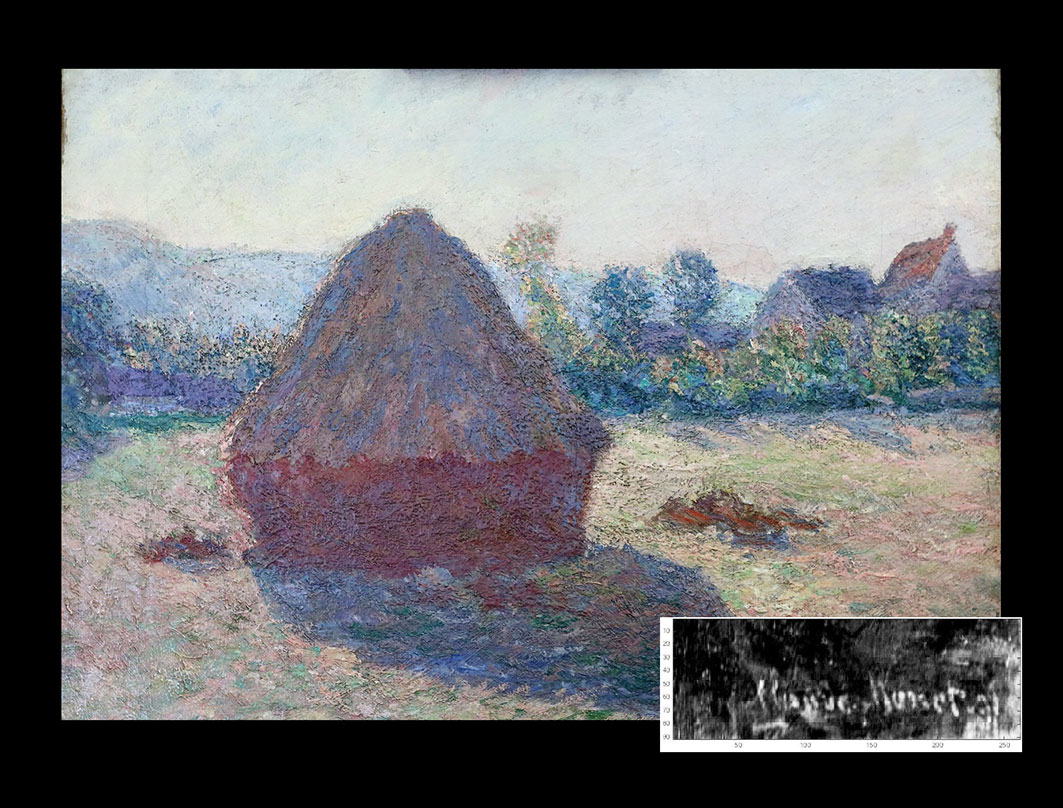

 Saving...
Saving...